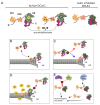Structure-Guided Prediction of the Functional Impact of DCLK1 Mutations on Tumorigenesis
- PMID: 36979969
- PMCID: PMC10046695
- DOI: 10.3390/biomedicines11030990
Structure-Guided Prediction of the Functional Impact of DCLK1 Mutations on Tumorigenesis
Abstract
Doublecortin-like kinase 1 (DCLK1) is a functional serine/threonine (S/T)-kinase and a member of the doublecortin family of proteins which are characterized by their ability to bind to microtubules (MTs). DCLK1 is a proposed cancer driver gene, and its upregulation is associated with poor overall survival in several solid cancer types. However, how DCLK1 associates with MTs and how its kinase function contributes to pro-tumorigenic processes is poorly understood. This review builds on structural models to propose not only the specific functions of the domains but also attempts to predict the impact of individual somatic missense mutations on DCLK1 functions. Somatic missense mutations in DCLK1 are most frequently located within the N-terminal MT binding region and likely impact on the ability of DCLK1 to bind to αβ-tubulin and to polymerize and stabilize MTs. Moreover, the MT binding affinity of DCLK1 is negatively regulated by its auto-phosphorylation, and therefore mutations that affect kinase activity are predicted to indirectly alter MT dynamics. The emerging picture portrays DCLK1 as an MT-associated protein whose interactions with tubulin heterodimers and MTs are tightly controlled processes which, when disrupted, may confer pro-tumorigenic properties.
Keywords: DCLK1; DCX; PEST domain; cancer; cryo-EM; crystal structure; doublecortin domain; kinase; microtubules; missense mutations.
Conflict of interest statement
The authors declare no conflict of interest.
Figures





Similar articles
-
Biochemical and Structural Insights into Doublecortin-like Kinase Domain 1.Structure. 2016 Sep 6;24(9):1550-61. doi: 10.1016/j.str.2016.07.008. Epub 2016 Aug 18. Structure. 2016. PMID: 27545623
-
Structural studies of the doublecortin family of MAPs.Methods Cell Biol. 2013;115:27-48. doi: 10.1016/B978-0-12-407757-7.00003-7. Methods Cell Biol. 2013. PMID: 23973064
-
Doublecortin-like kinase 1 compromises DNA repair and induces chromosomal instability.Biochem Biophys Rep. 2018 Oct 30;16:130-137. doi: 10.1016/j.bbrep.2018.10.014. eCollection 2018 Dec. Biochem Biophys Rep. 2018. Retraction in: Biochem Biophys Rep. 2020 Sep 25;24:100799. doi: 10.1016/j.bbrep.2020.100799. PMID: 30417131 Free PMC article. Retracted.
-
Functional implication of Dclk1 and Dclk1-expressing cells in cancer.Small GTPases. 2017 Jul 3;8(3):164-171. doi: 10.1080/21541248.2016.1208792. Epub 2016 Jul 26. Small GTPases. 2017. PMID: 27458755 Free PMC article. Review.
-
Research Progress of DCLK1 Inhibitors as Cancer Therapeutics.Curr Med Chem. 2022;29(13):2261-2273. doi: 10.2174/0929867328666210709110721. Curr Med Chem. 2022. PMID: 34254905 Review.
Cited by
-
A Novel D-peptide modulates DCLK1 Gelsolin interactions, reducing PDAC tumor growth.Res Sq [Preprint]. 2025 Mar 11:rs.3.rs-6099914. doi: 10.21203/rs.3.rs-6099914/v1. Res Sq. 2025. PMID: 40162222 Free PMC article. Preprint.
References
Publication types
Grants and funding
LinkOut - more resources
Full Text Sources

